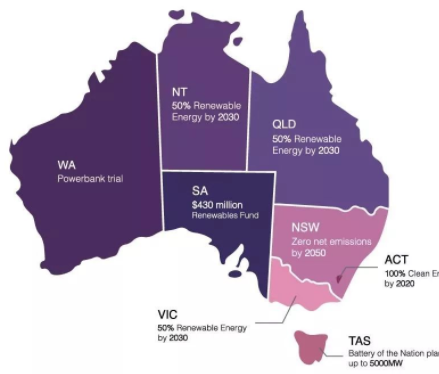The best era - Australia photovoltaic articles
Date:2019-09-05 origin:RCCN Visit:6498
Australian small data
Population: 25 million GDP per capita (2019-2023): 21 (from IMF data) Electricity consumption per person per year: 9742 kwh Average light intensity: 58 million Pascals per year
Australian PV market development and status
Australia is one of the most developed regions in the world for PV development. Since 2001, the photovoltaic system has been installed. In 2009, the subsidy policy was introduced. By the end of 2018, the total installed PV capacity was 11.28GW. During the 18 years, the Australian PV market has gradually undergone preliminary experiments. The household use is king, large-scale and now the most Good times. Australia has been among the best in the world's best PV market for many years under a strong subsidy policy, but the utility-level PV market has been stagnant. Until 2018, large-scale projects finally showed an explosive situation under the multiple policies of favorable policies, falling costs and high electricity prices, and the annual growth reached an unprecedented 2GW. Such a huge installation increase has brought a wealth of overseas investment and good employment rates to Australia. However, Australia's local supply chain is incomplete. Only a small number of important PV system components have localized production lines, and most rely on imports, especially from China.
Australian grid structure, electricity prices and photovoltaic standards
Australia, like China, has interconnected power grids in most regions, including Queensland (QLD), New South Wales (NSW), Capital Territory (ACT), Victoria (VIC), South Australia (SA) and Tasmany. Asia (TAS), the electricity market in these interconnected regions is known as the National Electricity Market. However, Western Australia (WA) and the Northern Territory (NT) are independent of each other and are not connected to the national electricity market. Australian electricity prices have risen year after year. The average retail price in 2017 was 0.23 US cents, ranking the top ten in the world. StandardsAustralia is the sole standard setting body designated by the Australian federal government. Only PV modules and inverters that meet Australian standards (AS/NZS4777 and AS/NZS 5033) can be used for PV system design and installation. The only approved product list is updated by the Clean Energy Council. Australian and New Zealand standards and certifications are mutually acceptable, and products can be sold in another country as long as they are certified by one country.
Australian Clean Energy Industry Policy
The federal government has not yet updated its policy to replace the Renewable Energy Target policy that will expire at the end of 2020. The RET policy is currently considered too cautious by many industry players and does not meet Australia's future energy development.
Therefore, the promotion of large-scale projects is mainly based on the policies of various state governments, as shown below.
Australian electricity price mechanism
1 Spot Market is purely market-priced. The Australian institution that manages this market is the Australian Energy Market Operator. 2 Power Purchase Agreement (PPA) The most popular large-scale new energy power trading method in recent years. The power generation party signs a contract with the electricity supplier or the power retailer for a period of 5-12 years. The change of the electricity price must follow the contract. Rules are a less risky approach for both power producers and consumers. 3 Power Internet subsidy (FiT) is applicable to photovoltaic systems with a size below 100kw. The subsidies for each power retailer in each region are different, but they are currently being reduced due to the decline in system costs.
4 CFDs are used by the Victorian Government for the first time in Australia. In the early stage, a tender will be organized. After the bidding of the power generation party is successful, a contract will be signed with the government. The contract stipulates a fixed price. After the project is connected to the grid, if the market electricity price is higher than the contract price, the power producer needs to refund the price difference to the purchaser. If the market electricity price is lower than the contract price, the government will subsidize the power producer.
How to participate in the Australian household photovoltaic project
After years of development of household PV in Australia, the supply chain is very mature (as shown below).
For Chinese producers, there are only two ways to enter the Australian market, one to establish a production line in the local area and the second to pass local agents. However, due to factors such as cost and channel, companies usually choose the second method. It is especially important to choose agents and distributors with better resources.
How to participate in large-scale photovoltaic projects in Australia
Large project development process (pictured)
Manufacturer: Seeking a partnership from an EPC or a developer; or looking for a (locally strong) complementary product manufacturer
Developer: Set up a branch in the local area or a joint venture with a local company
Investment company: investing in shares to participate in pre-project financing; purchasing connected grid-connected PV assets with stable income (minimum risk) In today's Australian power market, grid-connected access is the most important part for overseas investors, with local experience The design company and the provider of medium and high voltage power access products can help investors get access to the project more smoothly.
The Australian PV market has entered the best era, with abundant lighting resources and low technology maturity. Today's installed capacity is climbing, and many large enterprise consumers have joined the trend of purchasing photovoltaic power. State governments are very encouraged to invest in large projects to drive job growth and lower living costs. The widespread use of the Power Purchase Agreement (PPA) has also facilitated project financing and has driven the development of the entire market. At this time, whether as a producer or an investor, joining this market will yield a lot.
















 RCCN WeChat QrCode
RCCN WeChat QrCode Mobile WebSite
Mobile WebSite
